Linux and the Multiverse

A look at the rich diversity of Linux distributions.
What do Linux distributions and the Nobel Prize-winning work by Saul Perlmutter, Brian P. Schmidt and Adam G. Riess have in common? Well, Linux was originally the hobby project of one Linus Torvalds back in 1991 when he lived in Helsinki, Finland. Perlmutter, on the other hand, worked on the Supernova Cosmology Project at the Lawrence Berkeley National Laboratory and the University of California in Berkeley. Schmidt was part of the High-z Supernova Search Team at Australian National University, and Riess was also on the High-z Supernova Search Team but worked out of Johns Hopkins University and Space Telescope Science Institute in Baltimore.
You see where I'm going with this? The supernova team won the 2011 Nobel Prize for physics for "the discovery of the accelerating expansion of the Universe through observations of distant supernovae". In short, they discovered that the universe is not only expanding, as Edwin Hubble observed back in 1929 when he noticed that everything seemed to be moving away from us, but that the expansion was accelerating. This is a big deal, because everyone assumed that gravity would eventually do its dirty work and slow the whole expanding mess down. That turns out not to be the case.
So what's causing this anti-gravity force? Dark energy, for which the team actually came up with a number, a number which, as it turns out, is super tiny and its source, unknown. Later work, based on these observations, suggests that string theory might hold the answer, while others point to the Higgs Field, long theorized but only recently confirmed. Spoiler alert: nobody knows for sure, but if you follow this whole thing down the proverbial rabbit hole, you wind up concluding that there are countless universes in addition to our own—what we now refer to as the multiverse.
Just as the possibility exists for countless universes, so does the possibility exist for countless Linux distributions, When Linus chose to open the code for his new kernel, he unknowingly set in motion a kind of "distribution Big Bang", where the original code, combined with other open-source projects, began stretching out into the furthest reaches of the internet, where those combinations could spawn other versions of what eventually would form what we now think of as distributions. Just as matter from the early universe coalesced into dust clouds and then into stars that through their eventual cataclysmic destruction in supernovae would spawn the heavier elements that would, in time, create our own solar system with our planetary home, the Earth, so too did this early code evolve to create the rich diversity of Linux distributions.
We tend to think of our Earth as being a pretty mundane place, which is why we invented the Star Trek Federation, Agartha, Middle Earth, Narnia, Dune and Westeros. The same is true for Linux distributions. Sure, we all could be running a single version of Linux, like Red Hat or Ubuntu, but that would go against the very laws of the, ahem, multiverse. Just as we aren't always aware of the many universes that exist, you may not be aware as to just how many Linux distributions there are. Today, I'm going to give you a sample. Best of all, although it has proven to be insanely difficult to travel to any universe but our own, trying a different Linux distribution is as easy as downloading an ISO and rebooting. Welcome to the Linuverse.
To the Moon!
This one seems like a great place to start, because, well, it's out of this world. You can get
Lunar Linux (Figure 1) from lunar-linux.org where you'll find images compressed using the xz
format. Consequently, your first step is to unxz the file:
unxz lunar-1.7.0-x86_64.iso.xz
Lunar boots using a classic text screen, and that's something I never want to see disappear from the Linuverse. The installation is fascinating, because it's somewhat reminiscent of Slackware, with its blue text screen, but each item invites you to take "one step forward". If you mess up, you can take one step back. You'll be asked to select language and keyboard, and to partition your disk. There's a variety of tools for the latter, but I picked fdisk, just because. After jumping through a few hoops and answering a variety of questions, you'll need to install a kernel (which will be visible from the boot screen) and finally reboot.
Yes, this is a classic "Take chances, make mistakes and get messy" distribution, as Ms. Frizzle from the Magic School Bus would say. And, messy you will get. Once you boot and log in to root, the first thing you'll do is build your X environment from scratch. That's right:
lin XOrg7
That command will start a dialog asking you to choose the various installation components (Figure 1). Stay with me. This is actually fun.
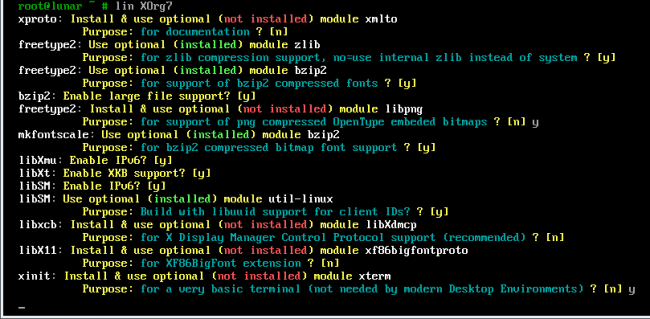
Figure 1. Lunar Linux, where anything you want, including X, you need to build.
Once you build X, you'll probably want a desktop with that distribution, so like X, you'll need to build that too. I happen to like KDE, so I decided to build that:
lin kde4
Substitute xfce4 for kde4 if you want XFCE or gnome2 if you want GNOME for your desktop
environment. If you're bored with the simplicity of apt-get or yum for installing packages, and you
long for those early days of compiling everything, Lunar is for you. A word of warning though: you
may find that the Lunar cache isn't always fresh, and lin might have trouble finding the odd
package. If that happens, visit the lunar download page on the web, find your package, and
download it manually. Oh, you'll definitely want to install "links" before you do that:
lin links
The repository is here. If you find yourself having to download a package, say "libpng", as I did, you'll need to install it by referencing your local directory (for example, /tmp):
lin -f /tmp -w 1.6.35 libpng
What that means is find the source bundle in /tmp where you want (the -w flag) version 1.6.35 of the
package. It's a strange bit of nostalgic fun, and I spent far more time on this than I would have
thought possible.
Paldo Linux
Maybe you don't want to start right from scratch, and you would fancy a desktop environment to work from, in which case you might want to try Paldo (Figure 2), which stands for "pure adaptable Linux distribution". Paldo is a strange beast in that it looks a lot like a typical GNOME-based desktop system, but the philosophy is one I hadn't run into before. Think of it as a source-and-binary hybrid where packages are built and binaries installed, but with all source and development files installed by default. Packages are not split, so you get everything related to that package. You can make local changes and use local "differential" repositories for maximum flexibility.
Another thing that sets Paldo apart from other distributions is its choice of package manager, UPKG. To install LibreOffice, for example, you would use the following command:
upkg-install libreoffice
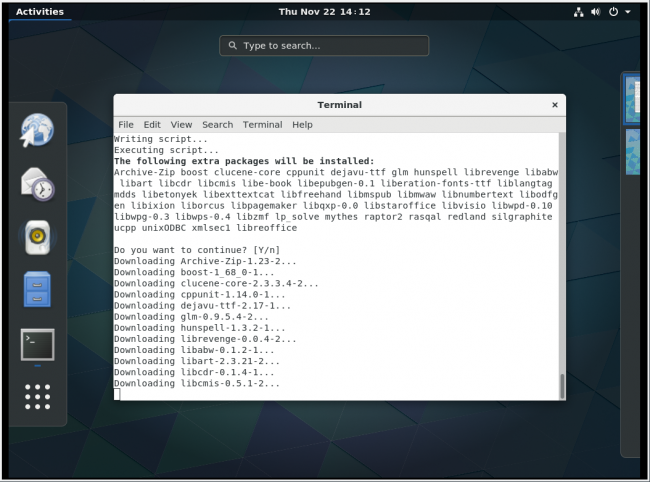
Figure 2. Using upkg to Install LibreOffice in Paldo
The upkg approach, along with Paldo's stated goal of building a "just works" system, does come at
a price. It does not provide an everything package that you might have come to expect, choosing instead
what it considers to be the right program for the right task. For instance, when it comes to
desktop environment, you have one choice: GNOME. Also, the source/binary approach means some
packages will download source and build locally, which can take some getting used to and is
definitely not recommended for anyone lacking in patience.
In another part of the Linuverse, Linux plays alongside Pokemon, Fullmetal Alchemist and Yu-Gi-Oh!, and the distribution they run is Linux Mangaka (Figure 3), a Manga-focused distribution based on Ubuntu LTS releases. The current version, Cho (Japanese for "butterfly"), runs Ubuntu 16.04 LTS with AIO (Japanese for "love"), which likely will be out by the time this article is published.
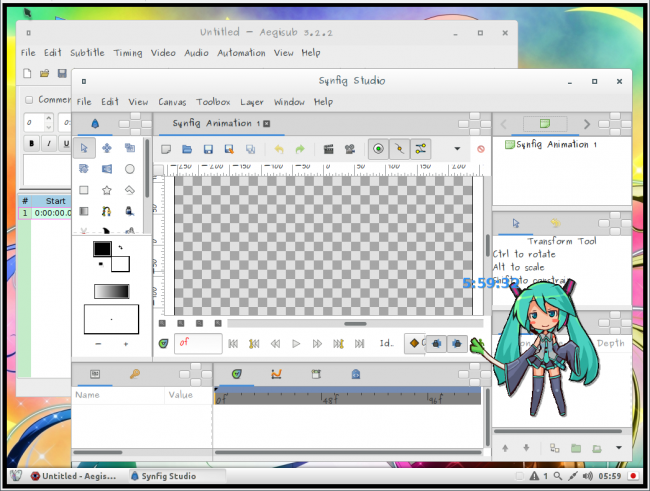
Figure 3. Linux Mangaka contains tools for Manga creators and enthusiasts.
Aside from the colorful Manga-styled desktop artwork, there's a serious distribution under the surface that's more than straight Ubuntu. In addition to things like Comix, a comic-book-reader app, there's Synfig, a powerful tool for creating 2D animation, and Aegisub, an application to allow fans to create their own subtitles for foreign language videos.
One more thing before I move on. In the Mangaka part of the Linuverse, the number-one favorite Manga is called Ubunchu!, the ongoing story of three young students in a school computer lab, all facing the challenges we encounter every day. It's truly inspiring stuff. We're lucky in that this Ubuntu-themed Manga, of which there are now seven issues, is available for download and your reading pleasure.
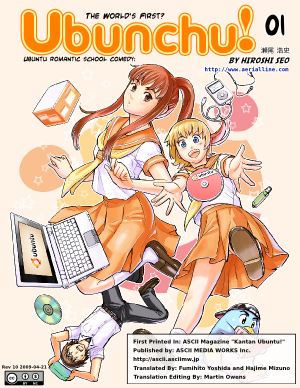
Figure 4. The First Issue of Ubunchu!, a Manga for Ubuntu Users
Now, it's time to get serious again. With infinite possibilities, you get some fascinating and highly specialized creations. For instance, eucalyptus leaves are far from nutritious and, for most animals, are actually poisonous. That doesn't stop Australia's Koala from living on a diet of these plants. With millions of years of evolution and some serious specialization, you can produce some pretty amazing creatures.
In the Linuverse, specialization can spawn fun distributions, like Hannah Montana Linux (seriously, go look it up; I'm not helping you with this one), but that also makes it possible to create distributions that focus on a collection of niche or industry-specific tools. Take Iro OS (Figure 5), a Linux distribution built specifically for animators, video and film producers, artists and others who work in the visual arts. It's also the first time I've seen the GNOME Pie menus, so that was a pretty cool discovery in and of itself. You can see the "3D and Video" menu opened up in the screenshot shown in Figure 5.
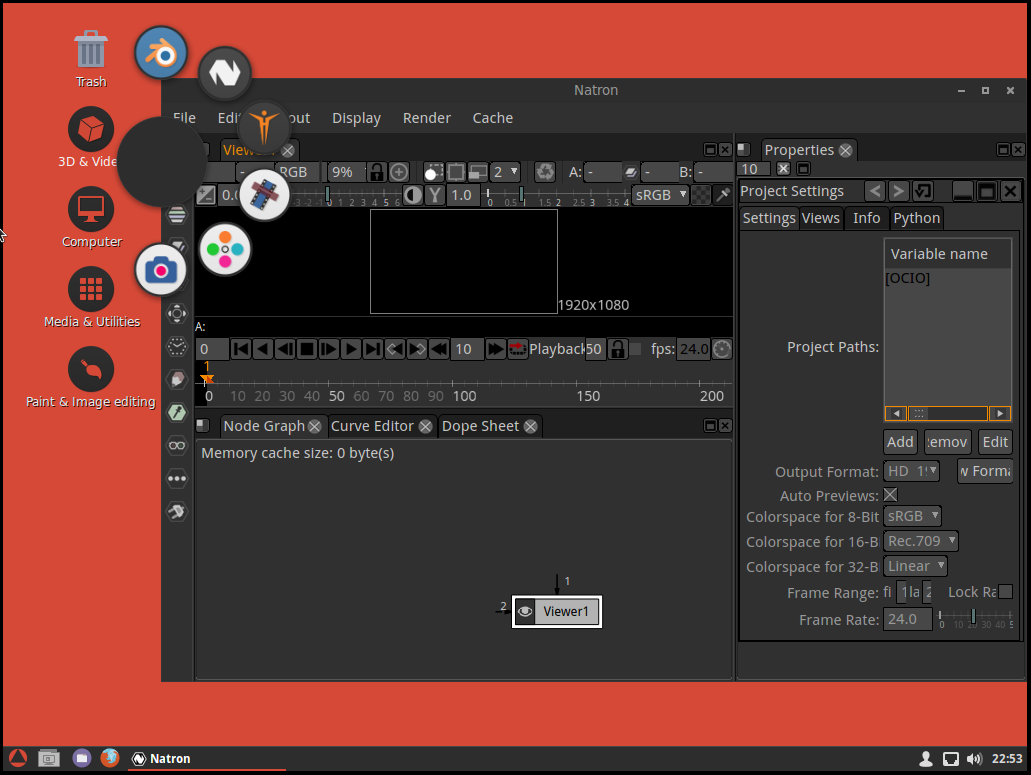
Figure 5. Iro OS, a Distribution for the Visual and Film Arts
The collection of applications is rich but industry-specific. There's Blender for 3D modeling and rendering, Inkscape for vector graphics, MakeHuman to create and render realistic anatomically correct human figures, Natron for node-based compositing, Kdenlive for video editing, Synfig (which I mentioned earlier), and a few more familiar apps like GIMP, Krita and others. It's a well thought out set of tools, and the distribution looks super slick in red and black.
Way, Way Outside!
With an infinite number of universes, there may be no end to the extent of "weird and wonderful" out there. Why should it be any different with the world of Linux and open source? I want to wrap up this exploration with a couple other distributions that, although not Linux-based, are fully open source, and give you a glimpse into that infinite collection of weird and wonderful.
Behold, my friends, an operating system for everypony—not everybody, but everypony. This is PonyOS (Figure 6). The developer of PonyOS swears that although it feels Linux-ish, the kernel is not Linux (or Hurd or Mimix, etc.), but rather it's something cooked up by the mind or minds behind this odd distribution. PonyOS has its own package manager, runs on a variety of hardware, albeit small, and it easily runs inside 512MB. It's so small, in fact, that I ran it entirely in memory and from the command line, like this:
qemu-system-i386 -m 512M -enable-kvm -soundhw ac97 ponyos.iso
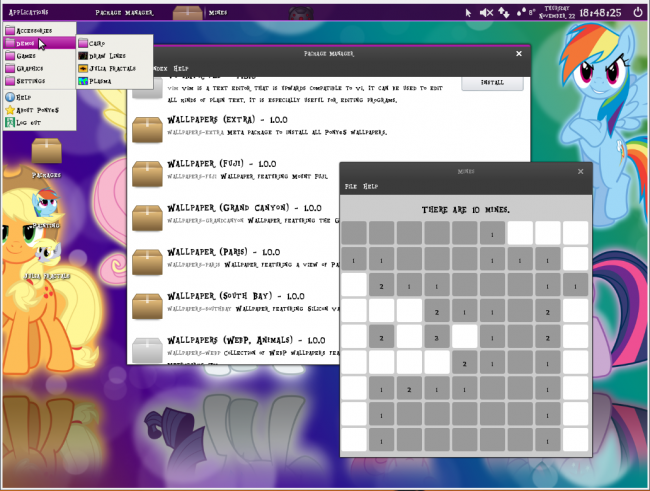
Figure 6. PonyOS, the OS for Everypony
You can open a terminal window and play some games, or open up vim and get creative—maybe cook up your own wacky distribution.
Reacting to Windows
Way back when, before Microsoft loved Linux (it says so right there on its website), there was a kind of friendly enemy relationship between the open world of Linux and the tightly closed world of Microsoft. Let's just say we didn't get along. Part of the Linux master plan was to get everyone to leave that terrible virus-prone Windows system and move to the land of rock-solid freedom that was the Linux desktop. In an effort to pull people away, we created all sorts of Windows-like desktops and even advertised them as such. Developers also built Wine, an open-source compatibility layer that would allow some Windows software to run on top of Linux.
Some people in the Open Source world, however, chose to go a lot further, and they created the altogether unmistakably Windows-like ReactOS (Figure 7).
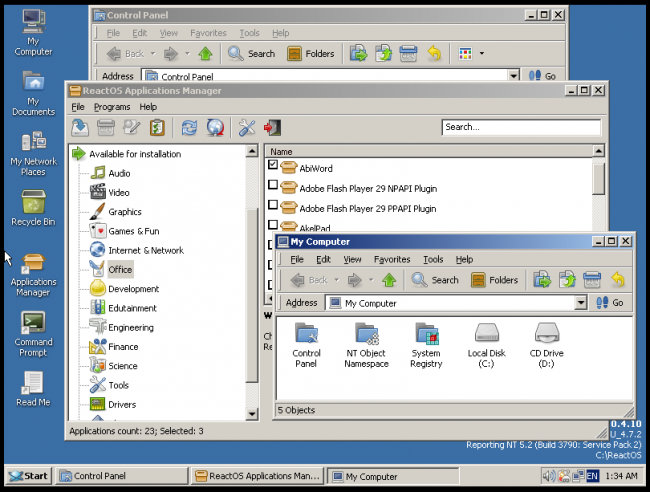
Figure 7. ReactOS even has a number of apps you can install from inside the OS.
Perhaps the most interesting thing about ReactOS is its resilience over time. When it first appeared, it was seen as more of a joke than anything else. Yet, years later, it's still going strong, with a large number of developers continuing to improve it. These days, it feels like an almost perfect copy of Windows NT, right down to the installation process. Most interesting is the number of apps that you can install from the Add/Remove Programs section of the Control Panel, including open-source programs like LibreOffice and GnuCash.
The Linuverse may not be totally infinite, but the potential for the new, the interesting, the strange and the downright bizarre means that your Linux and open-source journey has only just begun.
Now, let's see what other weirdness I can find.









